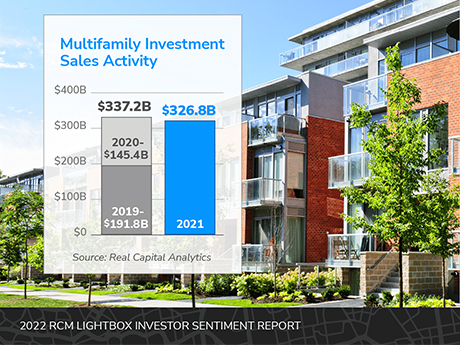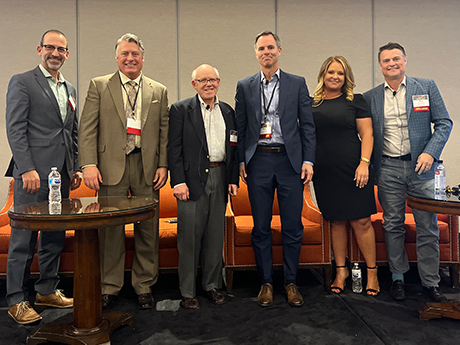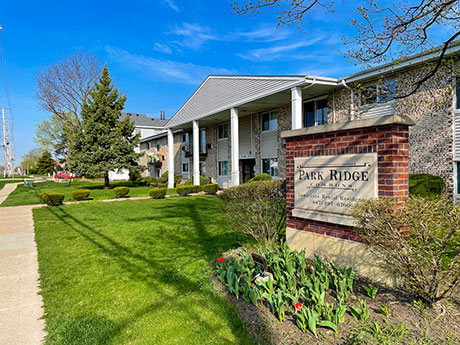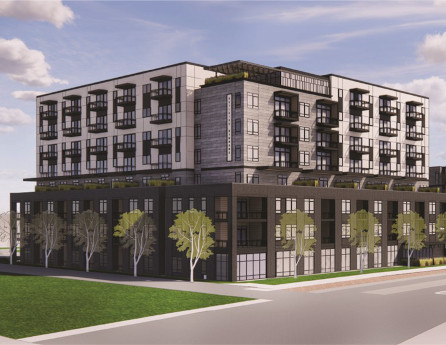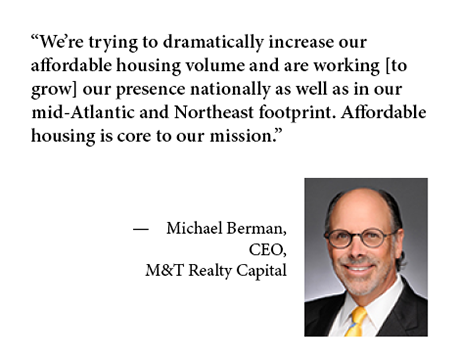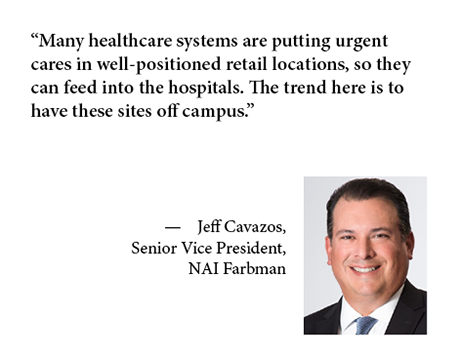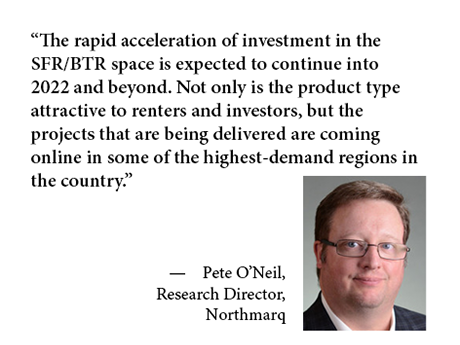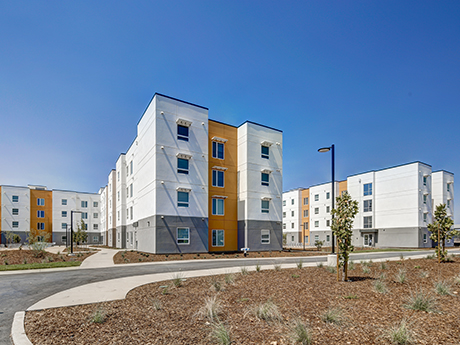If you know any architects, you may want to check in with them because chances are they’re exhausted from having more work now than ever before, with no end in sight. That’s because despite all the headwinds facing real estate design — namely supply chain disruptions and staffing woes — developers are in growth mode, and architects are needed as they are uniquely equipped to game plan for what users want and need. The volume of work has not only accelerated for architects but they’re also tasked with mapping out new requirements while maximizing flexibility, which is time-consuming and labor-intensive. The workload is getting so substantial that demand is exceeding the supply of architects in some instances. “The backlog is so significant that we are having to contemplate turning away work, which drives us crazy,” says Steve Goggans, principal and architect at SGA | NW, a GF design company. “We are trying to be most responsive to repeat clients, but we may find ourselves unable to produce and perform if we continue to take on work, so we are having to be a little more judicious than we ever have before.” Goggans says that SGA | NW’s logjam is also …
Features
CARLSBAD, CALIF. — Commercial real estate investors are navigating a delicate balancing act as strong demand across many sectors is hitting some headwinds from inflation, construction costs and labor issues. A first-quarter report by LightBox RCM highlights inflation’s double-edged sword as a driving force behind capital migration into the industry and increased costs across investment and construction sectors. The 2022 Q1 LightBox RCM Investor Sentiment Report found that 52.3 percent of industry professionals expect that investment activity will be somewhat or significantly higher than in 2021, despite a marketplace that faces increasing headwinds from price increases on materials and consumer goods, among other factors. An additional 20 percent expected slightly higher levels. At the same time, 35.4 percent of industry professionals believe investment sales pricing will be somewhat or significantly higher in 2022 than in 2021 and 36.9 percent say it will be slightly higher. “Today’s capital markets climate may be one of the most dynamic and intricate we’ve seen in many years,” says Tina Lichens, senior vice president of broker operations at LightBox, a Carlsbad-based analytics firm. “Investors are navigating a complex environment with significant opportunities as well as economic headwinds that are dictating a more nuanced approach. We expect to see …
LOS ANGELES — After bottoming out at 78.7 percent in the second quarter of 2021, private-pay seniors housing occupancy has been on a slow, steady climb, according to data from the National Investment Center for Seniors Housing and Care (NIC). The most recent data — for the fourth quarter of 2021 — showed occupancy at 81 percent. However, the pace of recovery varies widely among individual markets, individual companies and even individual properties. “Some people are able to manage the turmoil. Some are even thriving, or at least doing pretty well,” said J.P. LoMonaco, president of Valuation & Information Group. “Other people are really floundering. The questions I’m getting all revolve around occupancy, inflation, maintaining margins and revenue growth.” LoMonaco’s comments came as moderator during a panel titled, “The Power Panel: CEOs Discuss the State of the Industry” at France Media’s InterFace Seniors Housing West conference in Los Angeles on Feb. 24. Nearly 225 industry professionals attended the event. Other panelists included Chris Belford, CEO, Sinceri Senior Living; Rob Leinbach, principal, Cadence Living; Bill Pettit, president, R.D. Merrill Co.; Courtney Siegel, president and CEO, Oakmont Management Group; and Dave Sedgwick, president and CEO, CareTrust REIT. All the panelists reported their …
By Zach Demuth, Head of Americas Hotels Research, JLL Hotels & Hospitality Amid one of its most transformative periods in history, the U.S. lodging industry has an opportunity to enact real change through a renewed commitment to sustainability. As the world looks to reduce its carbon emissions, hotels play an important role, as they are the most energy- and water-intensive of any commercial building type globally. Not only will a commitment to sustainability help to slow climate change, but failure to do so also has the potential to result in lower asset value, increased operational costs and decreased consumer demand. Following the pandemic’s unprecedented impact on lodging demand, which was worse than that of 9/11 and the financial crisis of 2007-2008 combined, the industry demonstrated its resilience in 2021 with U.S. revenue per available room (RevPAR) reaching 83 percent of 2019 levels. While demand rebounded more quickly than most prognosticators expected, the industry continues to struggle to generate consistent profits, with gross operating profit per available room (GOPPAR) only recovered 71 percent relative to 2019. This has been driven by rising costs, lack of ancillary revenues and a historic labor shortage. As the industry looks to right-size profits, sustainability should …
While 2021 was a record year for multifamily investment sales, brokers see no sign of a slowdown. Some dealmakers anticipate that 2022 could be an even bigger year. In 2021, U.S. multifamily property and portfolio sales nationally totaled $335.3 billion, up 128 percent over the prior year, according to Real Capital Analytics. In 2021, Chicago-based Interra Realty sold or put under contract more than $527 million of apartment properties on behalf of clients, representing just under 3,000 units. Brad Feldman, senior managing partner, says that while some of those transactions carried into 2022, the total amount sold or under contract so far this year is more than 83 percent of the 2021 sales total. In one particular deal in 2021, Feldman represented a family trust in its sale of a Chicago multifamily property for the first time in 50 years. Situated in the city’s Lakeview neighborhood, the building features 21 apartment units and two commercial spaces. A private buyer paid $5.2 million for the asset and plans to renovate the units, hallways and common areas. Feldman completed about 30 showings and received more than six written offers. While today’s market tends to favor sellers, both sides of the transaction are …
ANNAPOLIS, Md. — Demand for seniors housing hit an all-time high in the second half of 2021, signifying continued growth out of the depths of the effects of the COVID-19 pandemic, according to the National Investment Center for Seniors Housing & Care (NIC). The analysis came in the form of a blog post by Beth Mace, NIC’s chief economist. NIC is an Annapolis-based nonprofit firm that tracks industry data gathered from 31 primary metropolitan markets through its NIC MAP Vision product. The demand was measured by absorption, with the market absorbing 21,029 units in the third and fourth quarter of 2021. “Notably, this is a clear reversal in trend from the loss of 42,129 units during the pandemic in the second, third and fourth quarters of 2020 and the first quarter of 2021,” wrote Mace. The post listed five major takeaways from the fourth-quarter 2021 data, the first of which is that occupancy has recovered 230 basis points from the low point of the pandemic, from 78.7 percent in the second quarter of 2021 to 81 percent in the fourth quarter of 2021. However, it remains 640 basis points below its pre-pandemic level of 87.4 percent. Mace noted, though, that …
M&T Realty Capital Corp. is beginning 2022 with ambitious plans to increase its multifamily financings as part of an effort to double its real estate loan volume over the next two to three years. To achieve those goals, it is leveraging a new leadership structure and a recently announced strategic partnership with the Marcus & Millichap Capital Corp. M&T Realty Capital, M&T Bank’s commercial mortgage banking subsidiary, recorded $5.1 billion in loan volume in 2021, a level that was just below its high watermark of $5.2 billion in 2019, says Michael Berman, CEO of M&T Realty Capital. Multifamily loans made up of the lion’s share of financings, he adds, and the sector provides a significant growth opportunity going forward. “Multifamily is a hot a sector right now — everyone is trying to invest in it,” he says. “It’s just an extraordinarily healthy asset class because of its supply and demand dynamics.” Indeed, the U.S. apartment market enjoyed a banner year in 2021 across all measures. Investment volume reached a record $335.3 billion, nearly 75 percent above the record volume of $193.1 billion posted in 2019, according to commercial real estate brokerage CBRE. Meanwhile, renters absorbed 617,500 apartment units in 2021, …
The famed stability of healthcare and medical office building (MOB) real estate continues in 2022, with the Midwest acting as a microcosm for the sector’s trends and challenges nationwide. Adapting to complement large healthcare system needs, adding urgent care centers and keeping costs low are some of the main concerns for brokers this space. Five healthcare/MOB brokers sat down with REBusinessOnline to discuss what is influencing the sector. Michael Kalil, chief operating officer and director of brokerage, and Jeff Cavazos, senior vice president, NAI Farbman, Southfield, Mich.; Matthew Gregory, senior VP office brokerage, and Michael Simpson, president, NAI Ohio Equities, Columbus, Ohio; and Doug Taatjes, partner/associate broker, NAI Wisinski of West Michigan, Grand Rapids, Mich. weighed in on the present and future of healthcare/MOB real estate. REBusiness: What trends are we going to see in healthcare in 2022? What factors might influence further investment in this field? Matt Gregory: Improvements to building infrastructure will be the most significant trend in 2022. There will be a push toward better HVAC filtration, higher cleaning standards and so forth. Mike Simpson: Yes, I think the healthy building initiative is something that’s going to pick up more momentum this year. Doug Taatjes: In our …
Build-to-RentContent PartnerFeaturesLeasing ActivityMidwestMultifamilyNortheastNorthmarqSingle-Family RentalSoutheastTexasWestern
Single-Family/Build-to-Rent: Changing Renter Demographics Fuel Growth
Demand for all forms of housing has been on the rise in recent years, a trend that is expected to continue in 2022. One segment of the market that is attracting significant attention is single-family/build-to-rent (SFR/BTR), as a series of economic and demographic shifts increase the attractiveness of an alternative to traditional apartments. Developers are ramping up activity on thousands of new units, particularly in the high-growth southern U.S. markets. Dozens of projects totaling more than $1.5 billion sold in 2021. Meanwhile, billions of dollars of debt and equity capital continue to move into this increasingly attractive investment class. Northmarq’s National Multifamily 2022 Outlook covers the record-setting momentum that multifamily properties across the United States saw last year and projects what the market may see in 2022. Northmarq’s full report is available here (with further rundowns on factors like the overall economy, rent trends, the investment market and financing climate). Their analysis on the SFR/BTR market below breaks down the trends and opportunities for growth in this burgeoning sector. Reasons for Growth Several factors are prompting the development of SFR/BTR. A primary influence is the changing mix of renters; today’s renters are generally older and more affluent than in the past. These …
Colleges, Universities Look More to Public-Private Partnerships for Student Housing Projects Post-Pandemic
by Katie Sloan
The pandemic isn’t entirely behind us yet, but many colleges and universities see the writing on the wall when it comes to funding future on-campus housing projects. Tighter budgets, more privacy, possible future closures, and nearly two years of delayed, deferred or canceled projects have driven a wedge between what establishments need to offer their students to remain competitive and what they have to work with. Enter public-private partnerships (P3). These arrangements between private investment firms and public universities have been bridging the funding gap for nearly 20 years. In a post-COVID world, however, their presence isn’t just appreciated, it’s vital in many instances. “COVID has shown how important P3 relationships are for institutions facing budget cuts and higher costs,” says Michael Leonczyk, director at Chicago-based Harrison Street. “There is a growing acceptance of P3s as a critical vehicle to allow higher education institutions to stay on the cutting edge when it comes to retaining and attracting students and ensuring they have access to resources that facilitate their academic and social lives. This includes housing, dining, parking, energy, water and athletics.” In 2003, there were three higher education P3 transactions, which totaled $100 million. By 2016, this number had swelled …



